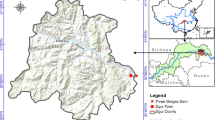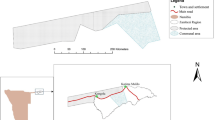Abstract
Proper assessment and early detection of land degradation and desertification is extremely important in arid and semi-arid ecosystems. Recent research has proposed to use the characteristics of spatial vegetation patterns, such as parameters derived from power-law modeling of vegetation patches, for detecting the early signs of desertification. However, contradictory results have been reported regarding the suitability of those proposed indicators. We used an experiment with multiple grazing intensities as an analog of a desertification gradient and evaluated the performance of two predictors of desertification: percent plant cover and a transition from a patch-area distribution characterized by a power law to another portrayed by a truncated power law, in a desert steppe in Inner Mongolia, China. We found that spatial metrics, such as the largest patch index and coefficient of variation of mean patch area had negative linear relationships with grazing intensity, suggesting that vegetation patches became more fragmented and homogeneous under higher grazing pressure. Using a binning-based method to analyze our dataset, we found that the patch-area relationship deviated from a power-law to a truncated power-law model with increasing grazing pressure, while the truncated power law was a better fit than the power law for all plots when binning was not used. These results suggest that the selection of methodology is crucial in using power-law models to detect changes in vegetation patterns. Plant cover was significantly correlated with stocking rate and all spatial metrics evaluated; however, the relationship between cover and vegetation spatial pattern still deserves a thorough examination, especially in other types of ecosystems, before using cover as a universal early sign of desertification. Our results highlight a strong connection between the vegetation spatial pattern and the desertification associated with heavy grazing and suggest that future studies should incorporate information about vegetation spatial pattern in monitoring desertification processes.




Similar content being viewed by others
References
Aguiar MR, Sala OE (1999) Patch structure, dynamics and implications for the functioning of arid ecosystems. Trends Ecol Evol 14(7):273–277
Bar Massada A, Gabay O, Perevolotsky A, Carmel Y (2008) Quantifying the effect of grazing and shrub-clearing on small scale spatial pattern of vegetation. Landscape Ecol 23(3):327–339
Bascompte J, Rodríguez MÁ (2001) Habitat patchiness and plant species richness. Ecol Lett 4(5):417–420
Bautista S, Mayor Á, Bourakhouadar J, Bellot J (2007) Plant spatial pattern predicts hillslope runoff and erosion in a semiarid Mediterranean landscape. Ecosystems 10(6):987–998
Burnham KP, Anderson DR (2002) Model selection and inference: a practical information-theoretic approach, 2nd edn. Springer-Verlag, New York
Cerdà A (1997) The effect of patchy distribution of Stipa tenacissima L. on runoff and erosion. J Arid Environ 36(1):37–51
Collins CD, Holt RD, Foster BL (2009) Patch size effects on plant species decline in an experimentally fragmented landscape. Ecology 90:2577–2588
Coppedge BR, Fuhlendorf SD, Harrell WC, Engle DM (2008) Avian community response to vegetation and structural features in grasslands managed with fire and grazing. Biol Conserv 141(5):1196–1203
Crist T, Pradhan-Devare S, Summerville K (2006) Spatial variation in insect community and species responses to habitat loss and plant community composition. Oecologia 147(3):510–521
ERDAS (2006) ERADS field guide. ERDAS, Atlantan, Georgia
Gardner R, Urban D (2007) Neutral models for testing landscape hypotheses. Landscape Ecol 22(1):15–29
Golden DM, Crist TO (1999) Experimental effects of habitat fragmentation on old-field canopy insects: community, guild and species responses. Oecologia 118(3):371–380
HilleRisLambers R, Rietkerk M, van den Bosch F, Prins HHT, de Kroon H (2001) Vegetation pattern formation in semi-arid grazing systems. Ecology 82(1):50–61
Jordano P, Bascompte J, Olesen JM (2003) Invariant properties in coevolutionary networks of plant–animal interactions. Ecol Lett 6(1):69–81
Joshi J, Stoll P, Rusterholz H-P, Schmid B, Dolt C, Baur B (2006) Small-scale experimental habitat fragmentation reduces colonization rates in species-rich grasslands. Oecologia 148(1):144–152
Kéfi S, Rietkerk M, Alados CL, Pueyo Y, Papanastasis VP, ElAich A, de Ruiter PC (2007) Spatial vegetation patterns and imminent desertification in Mediterranean arid ecosystems. Nature 449(7159):213–217
Levenberg K (1944) A method for the solution of certain non-linear problems in least squares. Q Appl Math 2:164–168
Li SG, Harazono Y, Oikawa T, Zhao HL, He ZY, Chang XL (2000) Grassland desertification by grazing and the resulting micrometeorological changes in Inner Mongolia. Agric For Meteorol 102(2–3):125–137
Lin Y, Hong M, Han G, Zhao M, Bai Y, Chang SX (2010) Grazing intensity affected spatial patterns of vegetation and soil fertility in a desert steppe. Agric Ecosyst Environ 138(3–4):282–292
Ludwig JA, Bartley R, Hawdon AA, Abbott BN, McJannet D (2007) Patch configuration non-linearly affects sediment loss across scales in a grazed catchment in north-east Australia. Ecosystems 10(5):839–845
Maestre FT, Cortina J (2004) Insights into ecosystem composition and function in a sequence of degraded semiarid steppes. Restor Ecol 12(4):494–502
Maestre FT, Escudero A (2009) Is the patch size distribution of vegetation a suitable indicator of desertification process? Ecology 90:1729–1735
Maestre FT, Escudero A (in press) Is the patch size distribution of vegetation a suitable indicator of desertification process?: Reply. Ecology
McGarigal K, Cushman SA, Neel MC, Ene E (2002) FRAGSTATS: spatial pattern analysis program for categorical maps. Computer software program produced by the authors at the University of Massachusetts, Amherst
Puigdefábregas J (2005) The role of vegetation patterns in structuring runoff and sediment fluxes in drylands. Earth Surf Processes Landforms 30:133–147
Reynolds JF, Virginia RA, Kemp PR, de Soyza AG, Tremmel DC (1999) Impact of drought on desert shrubs: effects of seasonality and degree of resource island development. Ecol Monogr 69(1):69–106
Rietkerk M, van de Koppel J (2008) Regular pattern formation in real ecosystems. Trends Ecol Evol 23(3):169–175
Rietkerk M, Boerlijst MC, van Langevelde F, HilleRisLambers R, van de Koppel J, Kumar L, Prins HHT, de Roos AM (2002) Self-organization of vegetation in arid ecosystems. Am Nat 160(4):524–530
Rietkerk M, Dekker SC, de Ruiter PC, van de Koppel J (2004) Self-organized patchiness and catastrophic shifts in ecosystems. Science 305(5692):1926–1929
Saalfeld A (1985) A fast rubber-sheeting transformation using simplical coordinates. CaGIS 12:169–173. doi:10.1559/152304085783915072
Scanlon TM, Caylor KK, Levin SA, Rodriguez-Iturbe I (2007) Positive feedbacks promote power-law clustering of Kalahari vegetation. Nature 449(7159):209–212
Schabenberger O, Gotway CA (2005) Statistical methods for spatial data analysis. Chapman & Hall/CRC, Boca Raton, FL, USA
Schlesinger WH, Raikes JA, Hartley AE, Cross AF (1996) On the spatial pattern of soil nutrients in desert ecosystems. Ecology 77(2):364–374
Su YZ, Li YL, Cui JY, Zhao WZ (2005) Influences of continuous grazing and livestock exclusion on soil properties in a degraded sandy grassland, Inner Mongolia, northern China. Catena 59(3):267–278
Verón SR, Paruelo JM, Oesterheld M (2006) Assessing desertification. J Arid Environ 66:751–763
White MS, Griffin P (1985) Piecewise linear rubber-sheet map transformations. CaGIS 12:123–131. doi:10.1559/152304085783915135
White EP, Enquist BJ, Green JL (2008) On estimating the exponent of power-law frequency distributions. Ecology 89(4):905–912
Wu Y-P, Pan X-B (2005) Analysis on biologic climate resources and its changes in Siziwangqi. J Arid Resour Environ 19:126–130
Wu XB, Thurow TL, Whisenant SG (2000) Fragmentation and changes in hydrologic function of tiger bush landscapes, south-west Niger. J Ecol 88(5):790–800
Zhao HL, Zhao XY, Zhou RL, Zhang TH, Drake S (2005) Desertification processes due to heavy grazing in sandy rangeland, Inner Mongolia. J Arid Environ 62:309–319
Zheng YR, Xie ZX, Robert C, Jiang LH, Shimizu H (2005) Did climate drive ecosystem change and induce desertification in Otindag sandy land, China over the past 40 years? J Arid Environ 64:523–541
Acknowledgments
We thank Zhen Wang, Liangliang Zhang, Shuangyang Zhang, Yuanheng Li, Jiajun Bai and Na Yu for their help in field measurements. We thank Fangliang He, James F. Cahill, Jr., Edward W. Bork, Xing Jin, Zheng Shi and Haiqing Lei for helpful advice on experiment design and data analysis. Comments from the coordinating editor and two anonymous reviewers significantly improved the manuscript. This study was financially supported by a Natural Science and Engineering Research Council of Canada grant to Scott X. Chang, the National Natural Science Foundation of China (30590832, 30860060) and the National Key Basic Research Program of China (2007CB106800) to Guodong Han and Mengli Zhao. Yang Lin was also supported by a travel grant from the China Institute, University of Alberta.
Author information
Authors and Affiliations
Corresponding author
Rights and permissions
About this article
Cite this article
Lin, Y., Han, G., Zhao, M. et al. Spatial vegetation patterns as early signs of desertification: a case study of a desert steppe in Inner Mongolia, China. Landscape Ecol 25, 1519–1527 (2010). https://doi.org/10.1007/s10980-010-9520-z
Received:
Accepted:
Published:
Issue Date:
DOI: https://doi.org/10.1007/s10980-010-9520-z




